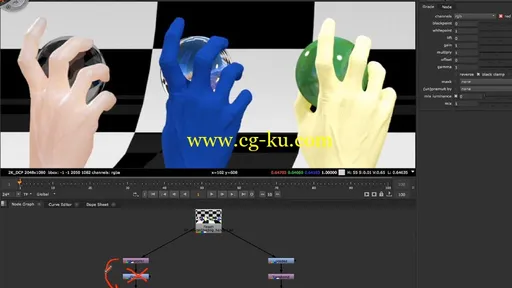
FXPHD – NUK231 NUKE Compositing Best Practices
Title: FXPHD – NUK231 NUKE Compositing Best Practices
Info:
Sometimes the creative process of digital compositing can be extremely complex specially when artists have too many technical tasks to focus on at the same time. In order to preserve an efficient workflow within a shot and across a whole project a smart methodology is required. Preserving high quality standards is as much important as deliver your best shot on-time. Being efficient should be as natural as breath, you don’t need to focus on it: you just do it without even thinking about that while your focus is where you really need it the most.
After years handling the highest quality standards in major VFX houses, prof Victor Perez brings you a selection of his best practices, procedures, methods, suggestions, advice, optimizations, tips and tricks; covering the main areas of compositing that you find in your day-by-day basis to become an efficient compositor and make your NUKE™ scripts look like Swiss clockwork.
Victor Perez is a senior visual effects artist with over 12 years of production experience in computer graphics, digital grading and visual effects along different countries. Nuke™ Official Certified Trainer by The Foundry®. As a senior digital compositing artist and 2D Technical Director he has a fine combination of both artistic and technical understanding of film postproduction and visual effects. Member of Visual Effects Society and usual collaborator of Nukepedia. Victor has worked and researched with Oscar® winner studios such as Cinesite and Double Negative between others. His film credits include The Dark Knight Rises (Dir. Christopher Nolan), Harry Potter and The Deathly Hollows: Part I (Dir. David Yates, 2010), Pirates of the Caribbean: On Stranger Tides (Dir. Rob Marshall, 2011), John Carter (Dir. Andrew Stanton, 2012), Lés Miserables (Dir. Tom Hooper, 2011).
course syllabus
Class 1: Understanding mind maps structures and organizing a nodal graphic representation of a compositing: from ideas to nodes. The complete guide to understand the Node Graph and its iconography. The art of backdropping and labeling. All the Merge operations explained.
Class 2: Concatenation of transformations: theory and practices for reducing the impact of filter and antialiasing issues. Bypassing nodes that break the concatenation. Applying transformations within other non-transformation nodes: Roto & RotoPaint.
Class 3: Implicit vs. explicit compositing streams: handling channels on a multichannel structure, masking procedures and issues, optimization of multistream parallel operations. Parallel vs. serial structure of a script, pros and cons.
Class 4: Handling a CG Multipass: implicit and explicit structures for building the Beauty: pros and cons. Single multichannel OpenEXR files vs. one-pass-per-file philosophy: Handling, compacting and expanding options. The additive and the subtractive synthesis of compositing the CG Beauty.
Class 5: The Boundary Box (BBox) demystified. How to handle it for optimal results. Nodes that modify the appearance of the Bbox: preserving or discarding, cropping and handling the information beyond the format. The Merge and the BBox. Autocrop unuseful areas. The BBox through the 3D space.
Class 6: FX and process extraction. Methods for blending separated grain structures and the overall grain workflow issues. Building a Luminance Keyer. The Fringe and the Solarisation curve.
Class 7: Node optimizations: presets and defaults. Task oriented open structures vs. Groups/Gizmos enclosed structures. Implementing Nuke original nodes: rebidding a LightWrap open structure. Python generators from given data in nodes: the standard projection setup automatized. Recommendations for creating templates (Coverage Map Template case study), creating script template menu calls, focus on the CG multipass “universal” template.
Class 8: Relink procedures for handling files and paths structures within the Read node: Search & Replace on text editors, python scripting for automatic replacement, building a Relink node and its Nuke Expressions, script-relative paths, Search & Replace panel (using Frank Rueter’s Nukepedia Python), OS-relative path replacements.
Class 9: ScanlineRender node optimizations: the “bg” input, creating ID passes, separating elements from renders, holdout operations and layering, integrating native deep image compositing options from Nuke 3D space renders, the disjoint-over operation. Channel optimization.
Class 10: 4K plates in a 2K workflow: data extraction and patch generation. The Python “loop’” for modifying knobs in several nodes at once. The Relight structure and the filtering issue: generating manual antialias, the double fusion relight pass merge method. Alpha masking for Merge operations. 3rd Party Python, Gizmos and Plugins.
数码 — — NUK231 核合成的最佳做法
标题: 数码 — — NUK231 核合成的最佳做法
信息:
有时数码合成的创造性过程可以极其复杂特别当艺术家有太多的技术任务,把重点放在同一时间。如何保持高效的工作流程,在一个镜头内和整个项目的智能方法是必需的。保持高质量的标准是一样重要的交付您的最佳拍摄时间上。作为高效应该像呼吸一样自然,你不需要把重点放在它: 你就是没有它甚至思考,虽然你的重点是在那里你真的它最需要的。
年处理最高质量标准的主要视觉特效的房子后,教授维克托 · 佩雷斯带给你选择他最佳做法、程序、 方法、 建议、 咨询、 优化、 提示和技巧;涵盖各主要领域的合成,你发现在你每天白天基础上成为有效的排序,为你 NUKE ™ 脚本看起来像瑞士钟表机构。
维克托 · 佩雷斯是资深视觉特效艺术家拥有超过 12 年的生产经验,在计算机图形学、 数字分级和沿不同国家的视觉效果。Nuke ™ 官方铸造 ® 认证培训师。作为高级数码合成艺术家和2D 技术总监他有艺术和技术的理解,电影后期制作和视觉效果的良好结合。视觉影响社会和平常合作者的 Nukepedia 成员。维克托有工作和研究了 Oscar ® 赢家的工作室 Cinesite 和双重否定其他之间。他的电影代表作包括黑暗骑士崛起 》 (导演克里斯托弗 · 诺兰)、 哈利· 波特和圣器: 第一部分 (导演 David 耶茨,2010年),加勒比海盗 4: 惊涛怪浪 (导演罗伯 · 马歇尔,2011年),约翰 · 卡特 (导演安德鲁 · 斯坦顿,2012年),Lés 悲惨 (导演汤姆 · 霍珀,2011年)。
课程大纲
1 班: 理解思维导图结构和组织合成节点的图形表示: 从想法到节点。完整的指南,了解节点图和其肖像。Backdropping 和标签的艺术。所有合并操作的都解释。
2 班: 串联的转换: 理论与实践为减少筛选器和抗锯齿的问题的影响。绕过打破串联的节点。应用在其他非转换节点内的转换: Roto & RotoPaint。
3 类: 显式合成流与隐式: 处理通道的多通道结构,掩蔽程序和问题,对多股流的并行操作的优化。并行与串行结构的脚本及利弊。
4 班: 处理 CG 多重曝光: 隐式和显式结构建筑之美: 利弊单多通道 OpenEXR 文件与每个文件一通哲学: 处理,压缩和扩展选项。添加剂和合成 CG 美减法合成。
第五类: 边界框 (BBox) 揭密。如何处理以达到最佳效果。修改的 Bbox 外观的节点: 保存或丢弃、 裁剪和处理之外的格式信息。合并和 BBox。自动裁剪无用的领域。通过 3D 空间BBox。
6 班: FX 和过程提取。共混的方法分离晶粒结构和总体的粮食工作流问题。建筑亮度键控器。边缘和日晒曲线。
7 班: 节点优化: 预设和默认值。面向任务的开放结构与群体/小玩意封闭结构。实施 Nuke 原始节点: 重新招标 LightWrap 打开结构。Python 发电机从给出的数据节点: 自动化的标准投影设置。有关创建模板 (覆盖地图模板案例研究),创建脚本模板菜单调用,建议集中在 CG 多程"通用"模板。
8 班: 重新链接程序处理读取节点内的文件和路径结构: 关于文本编辑器,python 脚本自动更换,建筑重新链接节点和其核弹表达式,脚本相对路径,搜索与替换面板 (使用弗兰克 RueterNukepedia Python),操作系统相对路径替换搜索与替换。
9 班: ScanlineRender 节点优化:"bg"输入,创建 ID 刀路,从呈现、 墨层操作和分层,分离元素整合深的本机映像合成选项从 Nuke 3D 空间呈现,作业不相交的。渠道优化。
类 10:4 K 2 K 工作流中的板: 数据提取和修补程序生成。Python"回路"一次修改旋钮在多个节点。点燃结构和滤波问题: 生成手动消除锯齿、 双融合点燃通合并法。合并操作的 alpha遮罩。第三方 Python、 小玩意和插件。